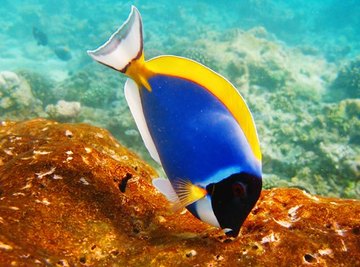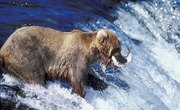
Every organism in an ecosystem is connected, even if the connections between organisms aren't immediately clear; in the wild, bears can't live without small plants, and a vulture can't safely exist without the insects hiding under desert rocks – not because the bear and the vulture eat the plants or insects, but because the plants and insects are important parts of the ecosystem's food chain. Secondary consumers like the bears and vultures are part of the food chain as well, but they operate differently than primary consumers or producers.
TL;DR (Too Long; Didn't Read)
In an ecosystem's food chain, a secondary consumer is any organism that eats primary consumers. Primary consumer examples include cows, insects that eat sap, or sea creatures like plankton or krill – and the birds, fish, coyotes and humans that eat them are secondary consumers. Secondary consumers can be either carnivores or omnivores, and their position on an energy pyramid can change depending on what they eat or choose to eat. For example, humans are often secondary consumers who eat cow, deer and poultry, but they can also be primary consumers by eating vegetables or tertiary consumers by eating salmon and other larger fish.
Connected Food Chains
In every ecosystem, there is a network of organisms feeding on each other to fuel their bodies with energy. This is the food chain, and ecologists represent the connections between organisms through the use of food webs and energy pyramids. These charts show the flow of energy between organisms and the relationships between predator and prey in a given environment, and are used to provide a better understanding of how everything in an ecosystem relates and connects. For instance, knowing that a specific plant is the only organism forming the base of an energy pyramid lets people know to protect that plant if they want to ensure that every other organism in the environment can stay healthy. Organisms in a food chain are assigned trophic levels depending on their role in the ecosystem.
Trophic Levels and Consumption
All living organisms are fueled by energy, and there are two primary methods of obtaining that energy: You can use photosynthesis to produce it, or you can eat another organism to consume it. Trophic levels are used to describe which of these methods an organism uses, and in the case of consumers, what types of organisms they eat. Plants that use photosynthesis are producers, at the lowest trophic level, and herbivore animals that eat those plants are known as primary consumers, one level above. Secondary consumers are at the third level, and tertiary consumers, organisms that eat secondary consumers, exist at the fourth level. Every time you move to a higher trophic level, an organism must eat more and eat more regularly to survive. This is because energy is lost every time it's transferred from consumer to consumer. Fungi and other organisms that obtain energy by decomposing dead organisms are in a category of their own and can be considered either the highest or lowest trophic level.
Secondary Consumer Basics
A secondary consumer is any organism that obtains energy by consuming a primary consumer, whether that primary consumer is an insect that eats berries, a cow that eats grass, or plankton that feed on algae underwater. Secondary consumers include owls, bears, lions and humans – along with many other organisms, and can be considered the predators in a given ecosystem. Many secondary consumers are carnivores, some of which are eaten by tertiary consumers. However, some secondary consumers are also tertiary consumers, which can be hard to understand.
Grow, Eat, Get Eaten
Not all food chains are simple; often, consumers will evolve to be able to eat more than a single organism or type of organism. At the same time, not all secondary consumers are carnivores. Omnivores complicate the energy pyramid and food web by being able to eat both plants and other consumer animals – and when you have organisms like humans that can eat a wide variety of foods, figuring out the food chain can be difficult. Organisms like this are assigned multiple trophic levels, and can sometimes be primary, secondary and tertiary consumers at the same time. As a human, you fall into this category: If you eat a vegetable, you're a primary consumer. If you eat beef, you become a secondary consumer – and if you eat salmon or another large fish, you become a tertiary consumer.
References
About the Author
Blake Flournoy is a writer, reporter, and researcher based out of Baltimore, MD. Working independently and alongside professors at Goucher College, they have produced and taught a number of educational programs and workshops for high school and college students in the Baltimore area, finding new ways to connect students to biology, psychology, and statistics. They have never seen Seinfeld and are deathly scared of wasps.
